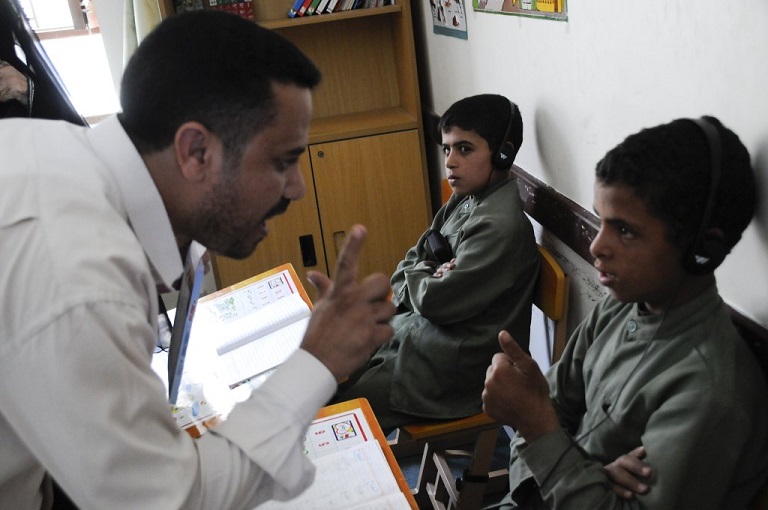This blog was originally posted on World Education Blog Posted on 11 March 2021 by GEM Report
About 34 million children worldwide have disabling hearing loss. Nearly 95% of deaf children are born to hearing parents, for whom sign language knowledge is crucial. Sign language introduces deaf children to basic expression and communication skills. Since most deaf children in low-resource settings start primary school with little or no language, the role of sign languages is essential for opening the pathway for progression in formal education, as it fosters access to the curriculum.

In 2018, however, just 41 countries worldwide recognize sign language as an official language, 21 of which are in the European Union. Moreover, there are hundreds of national sign languages, each with its morphology, phonology and syntax. For instance, Dutch Sign Language has seven dialects. The task is not straightforward.
Laws and policies count
There are several conventions and rules on the use of sign language in educating deaf children, including the United Nations Standard Rules on the Equalization of Opportunities for Persons with Disabilities, the UN Convention on the Rights of Persons with Disabilities and Article 16 of the legally binding 2018 Protocol to the African Charter on Human and Peoples’ Rights on the Rights of Persons with Disabilities in Africa.
Our review of laws and policies on inclusion, documented in the PEER country profiles, showed that a number of countries recognize sign language for instruction, including Ethiopia in its 2016 education law or Latvia, the Republic of Moldova and Slovenia. In the United States, 45 of the 50 states do.
Last month, Jamaica introduced sign language into its national curriculum. South Africa’s adult literacy programme, Kha Ri Gude, offers classes in all 11 official local languages, including sign language, and has recruited 60 sign language teachers to implement the programme.
In Georgia, sign language standards have been elaborated to assist inclusion of learners with hearing impairment, and standards for learners with visual impairment are in preparation. In Uzbekistan the Ministry of Preschool Education has developed a cycle of television programs and online classes, master classes and experiences for 3- to 7-year-old nomadic children, all of which are accompanied by sign language interpretation.
Test procedure accommodations are common. In Australia, as part of the Higher Education Participation and Partnerships Program, the Higher Education Disability Support Program covers costs for sign language interpreters, note taking and examination assistance. Students with severe oral communication difficulties can take written instead of oral examinations in Croatia, Georgia, Mongolia, North Macedonia, the Republic of Moldova and the Russian Federation.
NGOs were, of course, the first to provide services for deaf learners in much of the world and continue to do so in many contexts. For instance, the Association of Deaf Uruguayans established an institute of Uruguayan Sign Language and helped establish the Association for Parents and Friends of Deaf Uruguayans, which supports schools for the deaf to help children participate independently in social and economic life. As a result of such efforts, many governments recognize NGOs as equal partners in achieving inclusive education objectives
In Kenya, eKitabu’s Studio KSLproject integrates Kenyan Sign Language videos into digital children’s storybooks featuring locally relevant stories and characters, packaged in the open standard EPUBformat for wide access. The storybooks contain sign language glossaries and questions for teachers and children to use together.
ICT based approaches are also opening doors for the deaf. Microphone and receiver systems linked to students’ hearing aids have been used in universities in Scotland (United Kingdom) and Tunisia. At Bauman Moscow State Technical University, the Principal Educational, Research and Methodological Center for the deaf and hearing impaired offers bachelor’s and master’s degree programmes in computer science and engineering using ICT.
Whatever the method for adapting and accommodating education systems to those with hearing or oral difficulties, early and concrete interventions are necessary. If sign language is unrecognised, it results in linguistic deprivation, which makes learners vulnerable to abuse and can lead to cognitive delays and more.
However, even recognition does not imply implementation. In Zimbabwe, the government recognized sign-language as an official language in the 2013 Constitution, but its role in instruction is unclear. Most deaf children lack an appropriate environment to learn it at home. They learn it among themselves, with each school developing a separate system. Teachers in mainstream rural primary schools lack dictionaries, and large class sizes affect their ability to pay attention to deaf learners’ needs. Some teachers believe the sign language is a deficient communication system that deaf students can learn informally and independently. Some fear it interferes with learning the spoken language and are uncomfortable with the role of teaching assistants.
Learners often lack support. In India, as elsewhere, some students pay out of pocket for sign language interpreters.
The arrival of COVID-19 has made that task more complicated. Many of the learning materials issued during school closures did not take their needs into account. On top of this, the sudden requirement to wear a mask in the classroom has left those hard of hearing struggling to understand what the teacher is saying. Some met the challenge head on. In Uzbekistan, Armenia and Kazakhstan, the live video lessons run on national TV had sign language interpretation.
